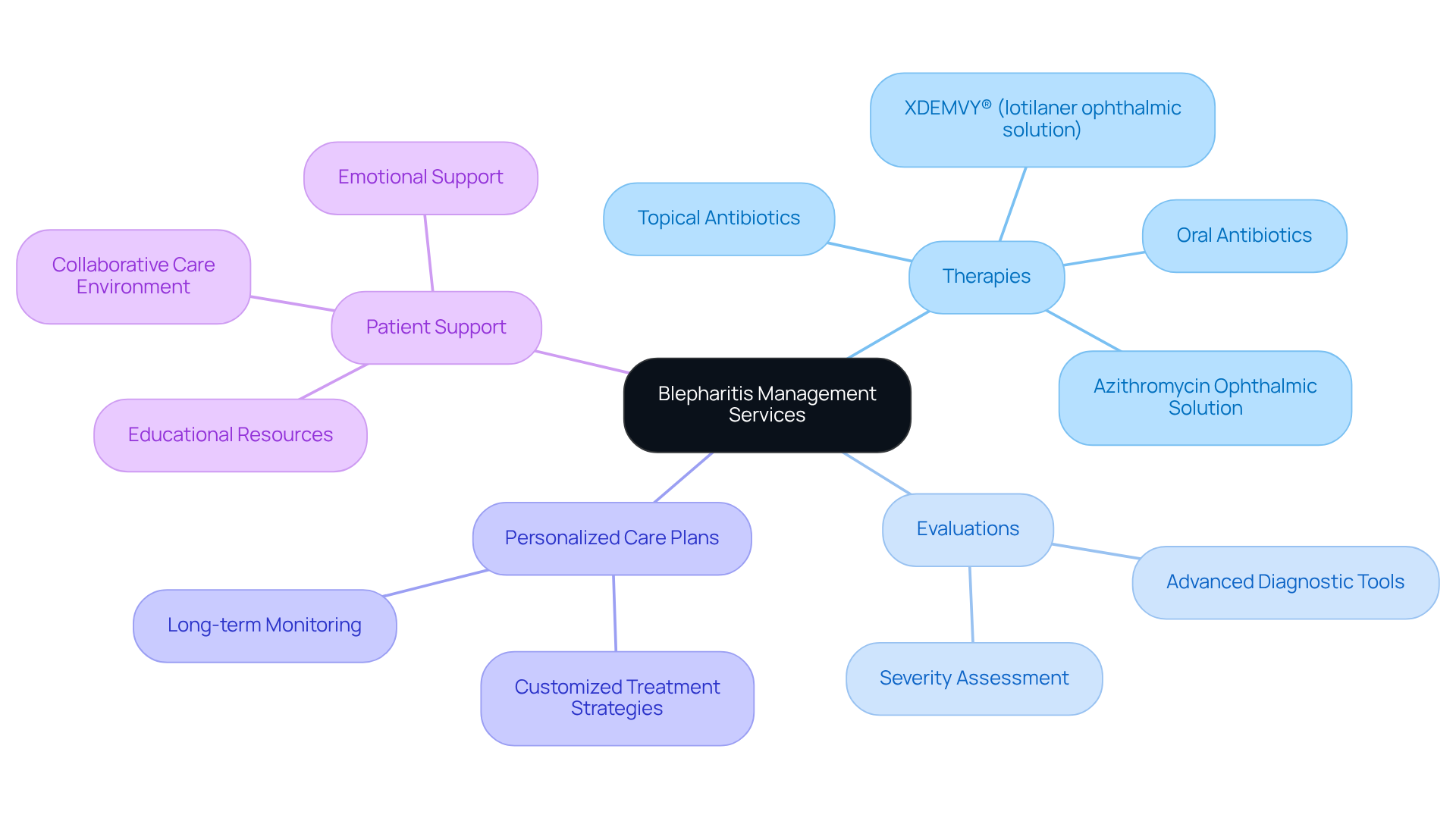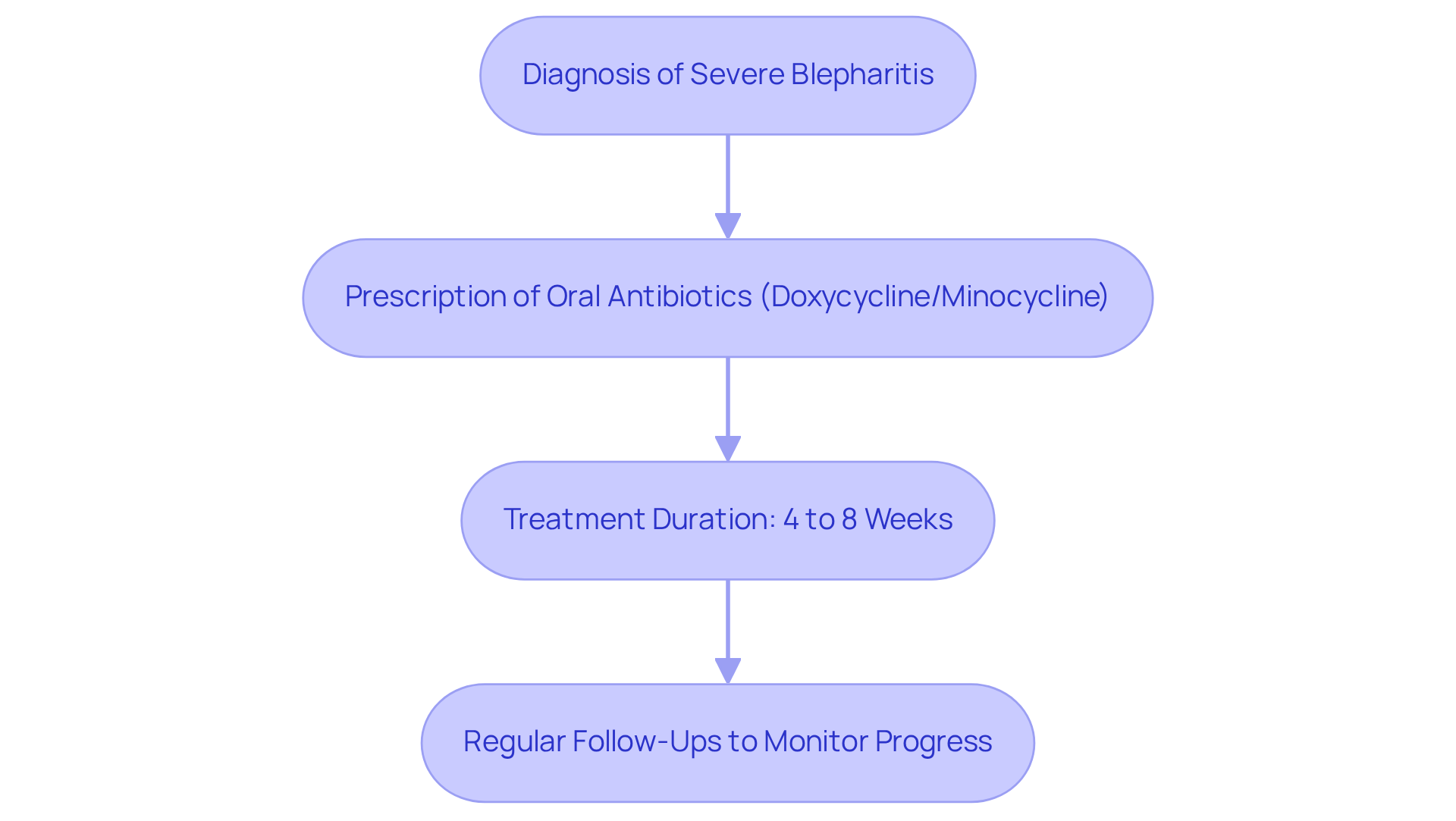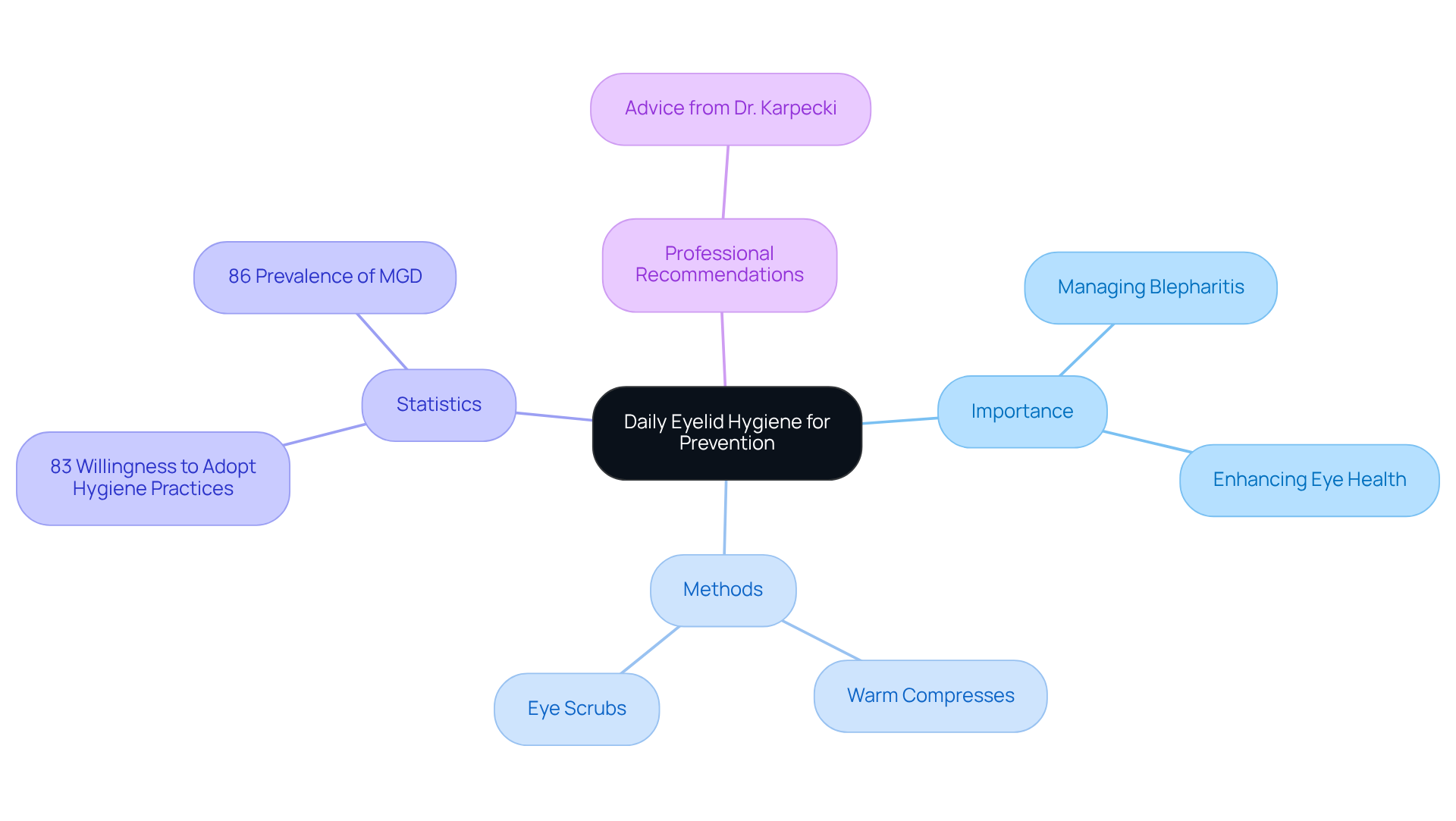Posted by: Northwest Eye in General on November 22, 2025
Introduction
Blepharitis is an often uncomfortable condition that causes inflammation of the eyelids, affecting countless individuals. We understand that many people may feel frustrated or confused about this issue, especially when it comes to finding effective therapies. This article explores seven proven strategies to alleviate symptoms and enhance your eye health. From topical and oral antibiotics to self-care practices and alternative medicine, there are various options available to help you manage this condition.
It’s common to feel overwhelmed by the complexities of blepharitis management. But rest assured, with the right information and support, you can navigate these challenges. We are here to help you through this process and guide you toward the most suitable approach for your needs.
Northwest Eye: Comprehensive Blepharitis Management Services
At Northwest Eye, we understand that dealing with eyelid inflammation can be concerning, which is why we offer various blepharitis therapies. That’s why we offer a comprehensive range of services tailored to your needs. Our approach includes thorough evaluations and personalized care plans, all while ensuring you feel supported and informed throughout your journey.
We employ advanced diagnostic tools to assess the severity of your eyelid inflammation. This allows us to customize our therapies specifically for you. Our expert team is dedicated to making sure you understand your condition and the blepharitis therapies available. We believe in fostering a collaborative environment that prioritizes your eye health.
We are here to help you through this process. As part of our patient-centered solutions, we aim to empower you with knowledge about your eye health. It’s common to have questions, and we want to ensure you receive the best care possible. Together, we can navigate this journey towards optimal eye health.

Topical Antibiotics: Targeting Bacterial Infections
If you’re dealing with eyelid inflammation, we understand how uncomfortable that can be and suggest considering blepharitis therapies. Topical antibiotics, such as erythromycin and bacitracin, are often prescribed in blepharitis therapies to help with bacterial infections related to this condition. These blepharitis therapies are gently applied directly to the eyelid margins, effectively working to reduce bacterial load and alleviate your symptoms.
These antibiotics are particularly beneficial for anterior eyelid inflammation, where blepharitis therapies address the significant role of bacterial colonization. It’s common to feel overwhelmed by the treatment process, but rest assured that following your ophthalmologist’s instructions regarding how often to apply the medication and for how long can lead to the best results.
Remember, you’re not alone in this journey. Many patients have found relief and comfort through blepharitis therapies, and we are here to help you through this process. Your well-being is our priority, and we encourage you to reach out with any questions or concerns you may have.

Oral Antibiotics: Systemic Solutions for Severe Cases
If you’re dealing with severe or chronic blepharitis, we understand how frustrating and uncomfortable managing blepharitis therapies can be. In some cases, your doctor may prescribe oral antibiotics like doxycycline or minocycline. These medications work systemically to reduce inflammation and tackle bacterial infections that topical treatments might not fully resolve.
Typically, a treatment duration of 4 to 8 weeks is recommended, depending on how you respond to the care. It’s important to have regular follow-ups to monitor your progress and make any necessary adjustments to your blepharitis therapies. Remember, you’re not alone in this journey; we are here to help you through the process.

Steroids: Reducing Inflammation and Discomfort
We understand that dealing with eyelid inflammation can be uncomfortable and concerning. Steroid medications, whether topical or oral, can be effective in reducing inflammation and discomfort linked to this condition. Topical steroids are often recommended for short-term relief during flare-ups, while oral steroids may be considered for more severe cases.
However, it’s important to approach long-term use of steroids with caution. Potential side effects, such as increased intraocular pressure, can lead to glaucoma. We encourage you to discuss the risks and benefits of steroid therapy with your ophthalmologist, as they can provide personalized guidance.
It’s also common to experience blurred vision, which can be a sign of various visual disorders, including:
- cataracts
- diabetic retinopathy
- dry eyes
- macular degeneration
These conditions may occur alongside eyelid inflammation, making it crucial to understand your symptoms. For cataract patients and others experiencing irritated eyes, recognizing these signs can indicate the need for further evaluation and treatment.
Remember, we are here to help you through this process. Your health and comfort are our top priorities.

Topical Lubrication: Alleviating Dryness and Irritation
Topical lubricants, such as artificial tears, play a vital role in easing the dryness and irritation that often accompany eyelid inflammation. We understand how uncomfortable symptoms like burning and discomfort can be, and these products are designed to help maintain moisture on the ocular surface, providing much-needed relief.
It’s common to feel overwhelmed during flare-ups, and we encourage you to use preservative-free lubricants multiple times a day. This simple action can significantly enhance your comfort and support your eye health. Remember, you’re not alone in this journey; many patients have found that consistent use of these lubricants has made a world of difference.
We are here to help you through this process, ensuring you have the tools you need for optimal eye care. Your comfort is our priority, and taking these steps can lead to a more pleasant experience as you manage your symptoms.
Self-Care Practices: Daily Eyelid Hygiene for Prevention
Daily eyelash hygiene is crucial for managing blepharitis therapies, and we understand how challenging this condition can be. Gently cleaning your eyelids with warm compresses and eye scrubs helps remove debris and excess oils. This simple practice not only alleviates symptoms but also plays a vital role in preventing future flare-ups. By incorporating eyelash hygiene into your daily routine, you can significantly enhance your overall eye health and comfort.
As blepharitis affects the eyelids, ongoing care is essential – both at home and with your doctor. It’s common to feel overwhelmed, but research shows that around 83% of patients are willing to adopt hygiene practices for their eyes when encouraged by their eye care providers. Moreover, it’s important to note that 86% of individuals experiencing dry eye also exhibit signs of meibomian gland dysfunction (MGD), which can complicate eyelid inflammation management.
Eye care professionals emphasize that maintaining eyelash hygiene is a proactive approach that can greatly improve your quality of life and is an important aspect of effective blepharitis therapies. Dr. Karpecki reminds us that hygiene can be key to successfully treating conditions with blepharitis therapies. Most people find that performing eyelid scrubs once daily, typically in the evening, maximizes their effectiveness. We are here to help you through this process, ensuring you feel supported every step of the way.

Alternative Medicine: Exploring Holistic Approaches to Blepharitis
Alternative medicine methods, particularly the use of tea tree oil (TTO) and omega-3 fatty acids, have become increasingly popular for treating eyelid inflammation. We understand that dealing with such conditions can be frustrating, and it’s important to explore options that may help. TTO is well-known for its antimicrobial properties, effectively targeting Demodex mites, which are often involved in blepharitis. In fact, studies show that 10 out of 11 patients who used TTO scrubs and shampoos found relief from their symptoms, highlighting its effectiveness in real-world scenarios. Additionally, TTO has demonstrated significant improvements in ocular surface symptoms and tear film stability, with a statistical significance of p < 0.001.
Omega-3 fatty acids also play a vital role in promoting eyelid health. Recommended dosages typically range from 1 to 3 grams, taken two to three times daily. However, it’s common to feel a bit impatient, as it may take six to twelve months to see definitive effects. Holistic health practitioners often emphasize the importance of these supplements in reducing inflammation and enhancing overall eye health.
If you’re considering these alternative therapies, we encourage you to consult with your ophthalmologist. It’s essential to ensure that these options can safely and effectively complement conventional methods. By integrating TTO and omega-3 supplements into a comprehensive treatment plan, you can take a multifaceted approach to managing blepharitis symptoms and utilizing effective blepharitis therapies to improve your eye health. Remember, we are here to help you through this process.

Conclusion
Managing blepharitis effectively requires a multifaceted approach tailored to your individual needs. We understand that dealing with this condition can be challenging, and it’s important to know that you’re not alone. This article highlights various therapies, from topical and oral antibiotics to steroid treatments, emphasizing their roles in alleviating symptoms and promoting your eye health.
Additionally, self-care practices and alternative medicine options like tea tree oil and omega-3 fatty acids offer holistic avenues for relief. This ensures that you have a comprehensive toolkit for managing your condition. Key insights include:
- The importance of personalized care plans
- The effectiveness of maintaining eyelid hygiene
- The potential benefits of integrating alternative treatments into traditional management strategies
Each of these elements contributes significantly to mitigating the discomfort associated with eyelid inflammation and enhancing your overall eye health.
Ultimately, proactive engagement in your eye care journey is crucial. By understanding the available therapies and adopting consistent self-care practices, you can take significant steps toward better eye health. Seeking guidance from healthcare professionals, such as those at Northwest Eye, ensures a supportive and informed approach to managing blepharitis effectively. Remember, we are here to help you through this process.
Frequently Asked Questions
What services does Northwest Eye offer for blepharitis management?
Northwest Eye offers a comprehensive range of blepharitis management services, including thorough evaluations, personalized care plans, and various therapies tailored to individual needs.
How does Northwest Eye assess the severity of eyelid inflammation?
Northwest Eye employs advanced diagnostic tools to assess the severity of eyelid inflammation, which allows them to customize therapies specifically for each patient.
What is the approach taken by Northwest Eye in managing blepharitis?
The approach includes providing thorough evaluations, creating personalized care plans, and fostering a collaborative environment that prioritizes patient understanding and eye health.
What are topical antibiotics used for in blepharitis therapies?
Topical antibiotics, such as erythromycin and bacitracin, are prescribed to help with bacterial infections related to blepharitis. They are applied directly to the eyelid margins to reduce bacterial load and alleviate symptoms.
For which type of eyelid inflammation are topical antibiotics particularly beneficial?
Topical antibiotics are particularly beneficial for anterior eyelid inflammation, where they address the significant role of bacterial colonization.
What should patients keep in mind when using topical antibiotics for blepharitis?
Patients should follow their ophthalmologist’s instructions regarding how often to apply the medication and for how long to achieve the best results.
How does Northwest Eye support patients during their treatment for blepharitis?
Northwest Eye aims to empower patients with knowledge about their eye health and encourages them to reach out with any questions or concerns throughout the treatment process.






